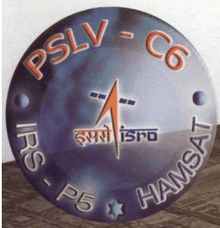PSLV-C6
|
Model of the PSLV rocket | |||||
| Names | HAMSAT mission | ||||
|---|---|---|---|---|---|
| Mission type | Deployment of two satellites. | ||||
| Operator | ISRO | ||||
| Website | ISRO website | ||||
| Mission duration | 1,120 seconds | ||||
| Spacecraft properties | |||||
| Spacecraft | Polar Satellite Launch Vehicle | ||||
| Spacecraft type | Expendable launch vehicle | ||||
| Manufacturer | ISRO | ||||
| Launch mass | 295,980 kilograms (652,520 lb) | ||||
| Payload mass | 1,602.5 kilograms (3,533 lb) | ||||
| Dimensions |
44.4 metres (146 ft) (overall height) | ||||
| Start of mission | |||||
| Launch date | 04:44:00, May 5, 2005 (UTC) | ||||
| Rocket | Polar Satellite Launch Vehicle | ||||
| Launch site | Sriharikota Launching Range | ||||
| Contractor | ISRO | ||||
| End of mission | |||||
| Disposal | Placed in graveyard orbit | ||||
| Deactivated | May 5, 2005 | ||||
| Orbital parameters | |||||
| Reference system | Sun-synchronous orbit | ||||
| Payload | |||||
|
| |||||
| Mass | 1,602.5 kilograms (3,533 lb) | ||||
 PSLV-C6, HAMSAT & IRS-P5 combined insignia
| |||||
PSLV-C6 was the sixth operational launch and overall ninth mission of the PSLV program. This launch was also the fifty-fourth launch by Indian Space Research Organisation since its first mission on 1 January 1962. The vehicle carried and injected India's two satellites; Cartosat-1 (a.k.a IRS-P5) and HAMSAT into the Sun-synchronous orbit. PSLV-C6 was launched at 04:44 hours Coordinated Universal Time (10:14 hours Indian Standard Time) on 5 May 2005 from the second launch pad of the Satish Dhawan Space Centre.[1][2][3][4][5]
Mission highlights
- Seventh operational launch of the PSLV program.
- Overall ninth mission of the PSLV program.
- Overall fifty-fourth launch by Indian Space Research Organisation.
- First flight to be launched from the second launch pad of Satish Dhawan Space Centre.
- Carried and injected two satellites built by ISRO.[6][7][8]
Mission parameters
- Mass:
- Total liftoff weight: 295,980 kilograms (652,520 lb)
- Payload weight: 1,602.5 kilograms (3,533 lb)
- Overall height: 44.4 metres (145.7 ft)
- Propellant:
- First stage: Solid HTPB based (138.0 + 6 x 9 tonnes)
- Second stage: Liquid UH 25 + N2O4 (41.5 tonnes)
- Third stage: Solid HTPB based (7.6 tonnes)
- Fourth stage: Liquid MMH + MON (2.5 tonnes)
- Engine:
- First stage: Core (PS 1) + 6 strap-on PSOM
- Second stage: Vikas
- Third stage: PS 3
- Fourth stage: PS 4
- Thrust:
- Altitude: 628.535 kilometres (391 mi)
- Maximum velocity:7,546 metres per second (24,757 ft/s) (recorded at time of payload separation)
- Duration: 1,120 seconds
Payload
PSLV-C6 carried and deployed two Indian satellites, Cartosat-1 (a.k.a IRS-P5) and HAMSAT into the Sun-synchronous orbit. Built by ISRO, Cartosat-1 was a stereoscopic remote sensing satellite and first of the Cartosat series of satellites.[5] HAMSAT was a microsatellite, built for providing satellite based amateur radio satellite to the national as well as the international community of amateur radio operators (HAM).[10]
| Country | Name | Nos | Mass | Type | Objective |
|---|---|---|---|---|---|
| | IRS-P5 | 1 | 1,560 kg | Satellite | Remote sensing satellite |
| HAMSAT | 1 | 42.5 kg | Microsatellite | Amateur radio satellite | |
Launch & planned flight profile
PSLV-C6 was launched at 04:44 hours Coordinated Universal Time (10:14 hours Indian Standard Time) on 5 May 2005 from the second launch pad of the Satish Dhawan Space Centre. The mission was planned with pre-flight prediction of covering overall distance of 622 kilometres (386 mi). Following was the flight profile.[9]
| Stage | Time (seconds) | Altitude (kilometer) | Velocity (meter/sec) | Event | Remarks |
|---|---|---|---|---|---|
| First stage | T+0 | 0.025 | 452 | Ignition of PS 1 | Lift off |
| T+1.19 | 0.026 | 452 | Ignition of 4 ground-lit PSOM | ||
| T+25 | 2.463 | 551 | Ignition of 2 air-lit PSOM | ||
| T+68 | 23.748 | 1,179 | Separation of 4 ground-lit PSOM | ||
| T+90 | 42.768 | 1,659 | Separation of 2 air-lit PSOM | ||
| T+112.03 | 67.411 | 1,995 | Separation of PS 1 | ||
| Second stage | T+112.23 | 67.635 | 1,994 | Ignition of PS 2 | |
| T+156.03 | 115.244 | 2,314 | Separation of heat shield | ||
| T+263.38 | 233.873 | 4,087 | Separation of PS 2 | ||
| Third stage | T+264.58 | 235.304 | 4,083 | Ignition of HPS 3 | |
| T+517.52 | 498.974 | 5,865 | Separation of HPS 3 | ||
| Fourth stage | T+531.50 | 509.092 | 5,851 | Ignition of PS 4 | |
| T+1,043.62 | 627.153 | 7,542 | Cut-off of PS 4 | ||
| T+1,080.62 | 627.801 | 7,546 | Cartosat-1 separation | ||
| T+1,120.62 | 628.535 | 7,546 | HAMSAT separation | Mission complete | |
See also
References
- ↑ "PSLV series". astronautix.com. Retrieved 28 August 2016.
- ↑ "PSLV-C6: A path-breaking launch". Business Standard. Retrieved 28 August 2016.
- ↑ "ISRO scientists meet Prime Minister". Indian Space Research Organisation. Retrieved 28 August 2016.
- ↑ "India's PSLV-C6 Successfully Launches 2 Satellites". spaceref.com. Retrieved 28 August 2016.
- 1 2 "PSLV-C6 launched from Sriharikota". The Economic Times. Retrieved 28 August 2016.
- 1 2 "PSLV-C6". Indian Space Research Organisation. Retrieved 28 August 2016.
- 1 2 "PSLV". spacelaunchreport.com. Retrieved 28 August 2016.
- ↑ "ISRO timeline". Indian Space Research Organisation. Retrieved 28 August 2016.
- 1 2 "PSLV-C6 brochure" (PDF). Indian Space Research Organisation. Retrieved 28 August 2016.
- ↑ "HAMSAT". Indian Space Research Organisation. Retrieved 28 August 2016.

